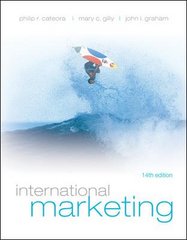Question
QUESTION 29 Why don't business firms typically produce public goods ? a.When a public good is provided to one person, it is automatically made available
QUESTION 29
Why don't business firms typically producepublic goods?
- a.When a public good is provided to one person, it is automatically made available without charge to other people.
- b.Public goods are usually poor-quality goods; therefore few people would want to buy them.
- c.Public goods are usually so costly, that only the wealthy could afford them.
- d.The more one person has of a public good, the less another person has.
QUESTION 30
Oligopolists haveincentiveto ______.
- a.compete rather than collude
- b.accept price as a parameter rather than setting price
- c.collude but also cheat on the collusive arrangement
- d.allow free entry, thus increasing the HHI of the industry
QUESTION 31
How does the course distinguish themotivation of the price-makerfrom themotivation of the price-taker?
- a.The price-maker wants to maximize profit, while the price-taker is concerned with the welfare of consumers.
- b.The price-maker wants to keep costs at a minimum, while the price-taker looks only at profit.
- c.The price-maker is prepared to give consumers a break even if it means less profit, while the price-taker is much tougher with consumers.
- d.There is no difference between the motivation of the price-maker and the motivation of the price-taker.
QUESTION 32
What are examples of an"artificially scarce good" ("club good")?
- a.whales and dolphins
- b.cable television and Netflix
- c.cigarettes and beer
- d.police and fire protection
QUESTION 33
How doGoogle and Facebookget theirrevenue?
- a.from government subsidies
- b.from voluntary contributions.
- c.by making their product artificially scarce.
- d.from advertising and selling information about users' characteristics and buying patterns
QUESTION 34
Suppose that a firm "shuts down" in the short run. By shutting down,the firm's loss (negative profit)is equal to ______ cost.
- a.marginal
- b.variable
- c.fixed
- d.total
QUESTION 35
Which of the following statements istrue?
- a.Airlines enhance profit by bundling, whereas Microsoft enhances profit by unbundling.
- b.The market demand for labor has an upward sloping segment (violating the "law of demand").
- c.It is normal for firms to have negative marginal cost.
- d.McDonald's is primarily a real-estate company.
QUESTION 36
(1) The monopolist demand curve isabovethe market demand curve.
(2) The monopolistdoes nothave a supply curve.
Which istrue?
- a.1
- b.2
- c.both 1 and 2
- d.neither 1 nor 2
QUESTION 37
Opsint,Visint, andHumintare ______.
- a.machine programming languages underlying your IDS courses
- b.sub-departments of Google's R&D operations
- c.names of robots that China is exporting
- d.techniques of industrial espionage
QUESTION 38
Many peoplespend more when using their debit or credit cards than when paying with the cash in their wallets. This is ______ behavior in the form of ______.
- a.rational, opportunity costs
- b.irrational, mental accounting
- c.competitive, sunk costs
- d.oligopolistic, the law of diminishing returns
QUESTION 39
What is theVMP of a robot in an automobile firm? It is "marginal product of the robot"timesthe ______.
- a.price of an automobile
- b.number of automobiles produced
- c.rental rate of the robot
- d.number of robots employed
QUESTION 40
An importantthemeof Economics 120 is that _____.
- a.government rules and regulations make the economy great
- b.the CEO can do good both for his/her firm and for society
- c.rational CEOs obey the law to the smallest detail
- d.business makes decisions based on ethics
Step by Step Solution
There are 3 Steps involved in it
Step: 1

Get Instant Access to Expert-Tailored Solutions
See step-by-step solutions with expert insights and AI powered tools for academic success
Step: 2

Step: 3

Ace Your Homework with AI
Get the answers you need in no time with our AI-driven, step-by-step assistance
Get Started


